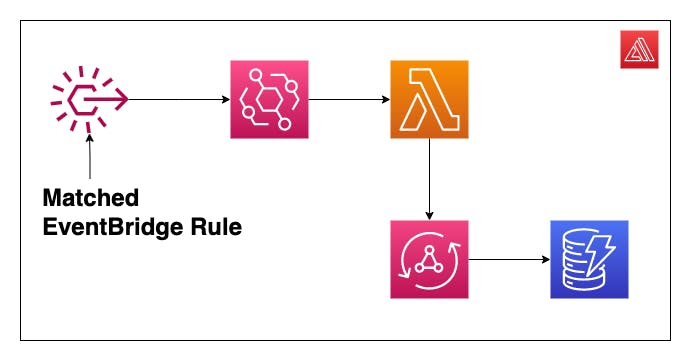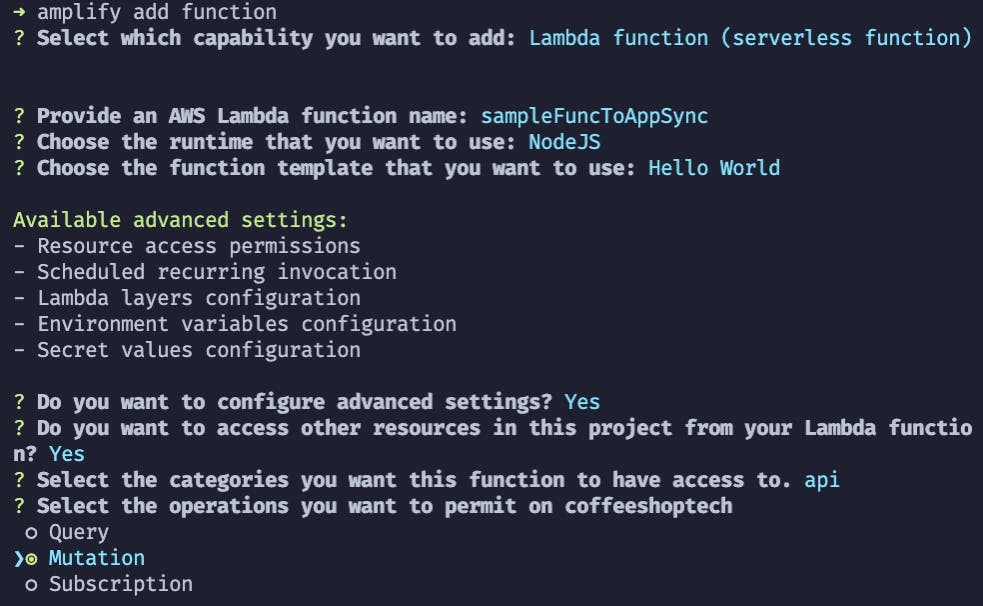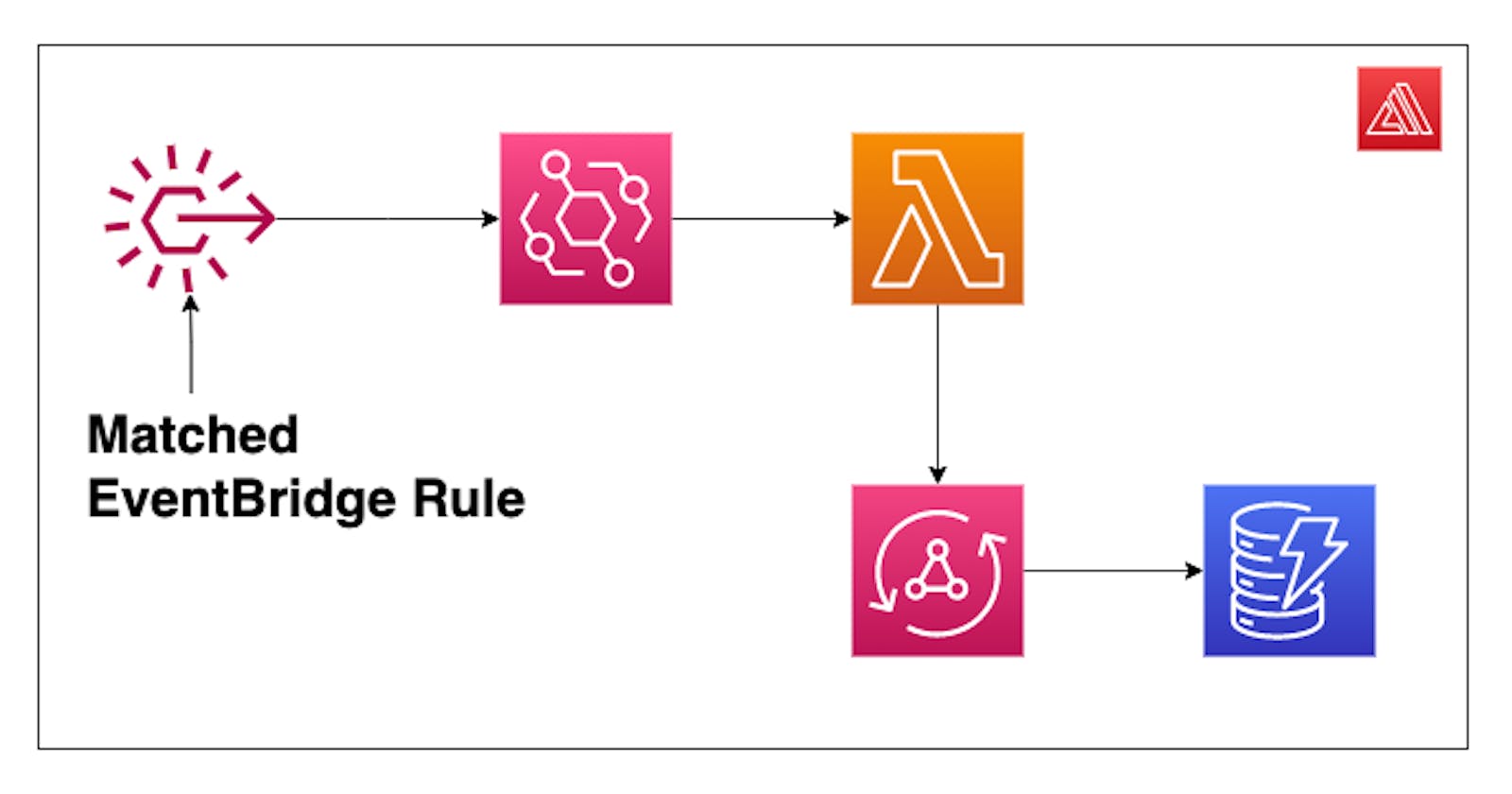AWS AppSync is a managed graphQL service that comes with built-in websockets so applications can subscribe to real-time updates. Oftentimes, this means something like, "When someone adds a todo, let any subscriber see the new todo."
But the actual use case can be much more interesting. In this post, we'll explore the following scenario:
"When a customer is close to a café, update their order from
PROCESSEDtoARRIVINGand notify a store in real-time that they can begin making it."
We'll explore the location tracking in the next post, but this post will assume that the customer is close enough to the store that it triggered the event and it's now our job to notify the store.
Understanding our services

The above image shows an event matching a rule on Amazon EventBridge.
The matched rule is then sent to an event bus in our account. The event bus routes the event to a Lambda function that calls an update mutation on our AppSync API.
The mutation (from AppSync), calls DynamoDB to update a field on our table.
🗒️ If needing a refresher on AppSync and it connecting to DynamoDB, I have a beginner-friendly video that's just for you!
Modeling our AppSync Schema
Let's take a look at what an AppSync schema would need to look like if wanting to do something like this.
🗒️Running
amplify add apiin an Amplify project will walk you through the steps to create an AppSync API😎
The below AppSync schema is decorated with directives from AWS Amplify, but the same principles apply:
type Order
@model
@auth(
rules: [
{ allow: private, operations: [create] }
{ allow: groups, groups: ["employee"], operations: [read] }
# EventBridge will automatically call this lambda function to update orders
{ allow: private, provider: iam, operations: [read, update] }
]
) {
id: ID!
products: [String!]! #They already paid, so we just need the product name(s)
status: ORDER_STATUS!
customerName: String!
}
enum ORDER_STATUS {
PROCESSED # The customer just clicked the "buy" button
ARRIVING # The customer just entered a geofence
FULFILLED #The employee gave the customer their order
}
The @model directive will automatically create a DynamoDB table with CRUD resolvers.
The @auth directive is where things get interesting. By specifying rules on our Order type, we can have fine-grained authorization on our API.
{ allow: private, operations: [create] }: Signed in users can create orders.{ allow: groups, groups: ["employee"], operations: [read] }: Users in the "employee" cognito group can read orders.{ allow: private, provider: iam, operations: [update] }: AWS services with IAM permissions to access are restricted to updating an order.
As you can see, AppSync's integration with Amazon Cognito makes setting up authZ (authorization) rules very easy. Amplify takes it a step further by managing the DynamoDB connections as well.
🔥Tip: When creating an AppSync API with Amplify, the CLI will ask if you'd like code generated for you. Selecting
yeswill add agraphqlfolder to your project withqueries.js,mutations.js, andsubscriptions.jsfiles. We'll take advantage of this shortly.
Creating a Lambda function
We want to create a Lambda function that gets called by EventBridge but also has permission to update our AppSync API by calling a mutation.
This can be done from the AWS console, but we'll again leverage AWS Amplify to handle this for us.
By leveraging the Amplify CLI, creating a new function that is associated with our AppSync API is as easy as answering a few questions.

As you can see, by running amplify add function, we're prompted to give our function a name, and runtime. As an advanced setting, you can associate the function with existing services in our application.
Selecting api will allow us to select the type of change we'd like to enable. This will update the function's IAM role with a policy that allows us to call a mutation.
As for the code in our Lambda function, because we told Amplify that we need access to our AppSync API, it will automatically provide a process.env variable for our AppSync endpoint.
The code to call our API looks like this:
/* Amplify Params - DO NOT EDIT
API_ORDERPROJECT_GRAPHQLAPIENDPOINTOUTPUT
API_COFFEESHOPTECH_GRAPHQLAPIIDOUTPUT
ENV
REGION
Amplify Params - DO NOT EDIT */
/**
* @type {import('@types/aws-lambda').APIGatewayProxyHandler}
*/
const AWS = require('aws-sdk')
const urlParse = require('url').URL
const fetch = require('node-fetch')
const updateOrder = require('./graphql/mutations').updateOrder
exports.handler = async (event) => {
const appsyncUrl = process.env.API_ORDERPROJECT_GRAPHQLAPIENDPOINTOUTPUT
const region = process.env.REGION
//same as appsyncUrl but without the "https://"
const endpoint = new urlParse(appsyncUrl).hostname
const httpRequest = new AWS.HttpRequest(appsyncUrl, region)
httpRequest.headers.host = endpoint
httpRequest.headers['Content-Type'] = 'application/json'
httpRequest.method = 'POST'
//request to update an order with AppSync start
const updateOrderById = (id) => {
const updateOrderBody = {
query: updateOrder,
operationName: 'UpdateOrder',
variables: {
input: {
id,
status: 'ARRIVING',
},
},
}
httpRequest.body = JSON.stringify(updateOrderBody)
signer = new AWS.Signers.V4(httpRequest, 'appsync', true)
signer.addAuthorization(AWS.config.credentials, AWS.util.date.getDate())
const options = {
method: httpRequest.method,
body: httpRequest.body,
headers: httpRequest.headers,
}
return fetch(appsyncUrl, options).then((res) => res.json())
} //request to update an order with AppSync end
//make the call to update an order, sending the updated order back to the client
try {
const { orderId } = event.detail
const updatedOrder = await updateOrderById(orderId)
return {
statusCode: 200,
body: updatedOrder,
}
} catch (e) {
console.log({ error: e })
return { statusCode: 404, body: { error: e } }
}
}
While it may look complicated, let's break it down.
- Using the graphql endpoint Amplify provided to us, we pass it to the native
URLpackage in NodeJS. This returns an object that contains the parts of our API such ashost,hostname,href, etc.
We're mainly using it to go from https://our-api.com to just our-api.com.
- We attach the host as well as a couple of other properties to our headers.
- We create a function that will call our AppSync API by taking in the ID of the order we're updating.
- Inside of that function, we stub out the body of our request and stringify it.
- We sign the request so that AWS knows it's trusted and can be used for AppSync.
- Using those now-signed headers, we pass the URL and the headers to our
fetchrequest.
🗒️Because
fetchhas landed innodev17, I'm using thenode-fetchpackage to make modifying this function in the future simpler.🔥 Remember in the API section above that I mentioned Amplify will automatically generate the
queries, andmutations? Notice that I simply copied that file over to this Lambda function's directory hence the line:const updateOrder = require('./graphql/mutations').updateOrder
Now when this function is triggered, it will update our AppSync API and any subscribed listeners will get notified
Listening for API updates
In a frontend application, you can use the API module from the aws-amplify package to subscribe to events. An example for doing so in a react app would look like the following:
useEffect(() => {
const subscription = API.graphql({
query: onUpdateOrder,
}).subscribe({
next: ({ provider, value }) => {
console.log({ provider, value })
if (value.data.onUpdateOrder.status === 'ARRIVING') {
setOrders((currentOrders) => {
return [value.data.onUpdateOrder, ...currentOrders]
})
}
},
})
return () => {
subscription.unsubscribe()
}
}, [])
Setting up EventBridge
Let's go the extra mile on this post and show how one would set up EventBridge to send the event.
Again, this can be done from the AWS console, but we'll use Amplify to create the EventBridge rule, add our function as a target.
Running the command amplify add custom and selecting CDK will scaffold out a CDK application that is aware of our Amplify project.
During scaffolding, we also import a AmplifyDependentResourcesAttributes object that contains all the references to our Amplify-generated services. We'll use that to grab our function:
import * as cdk from '@aws-cdk/core'
import * as AmplifyHelpers from '@aws-amplify/cli-extensibility-helper'
import { AmplifyDependentResourcesAttributes } from '../../types/amplify-dependent-resources-ref'
import * as events from '@aws-cdk/aws-events'
import * as targets from '@aws-cdk/aws-events-targets'
import * as lambda from '@aws-cdk/aws-lambda'
export class cdkStack extends cdk.Stack {
constructor(
scope: cdk.Construct,
id: string,
props?: cdk.StackProps,
amplifyResourceProps?: AmplifyHelpers.AmplifyResourceProps
) {
super(scope, id, props)
/* Do not remove - Amplify CLI automatically injects the current deployment environment in this input parameter */
new cdk.CfnParameter(this, 'env', {
type: 'String',
description: 'Current Amplify CLI env name',
})
const rule = new events.Rule(this, 'cafeCustomerEnter', {
eventPattern: {
source: ['aws.geo'],
detailType: ['Location Geofence Event'],
detail: {
EventType: ['ENTER'],
},
},
})
//grab a reference to our Amplify function
const retVal: AmplifyDependentResourcesAttributes =
AmplifyHelpers.addResourceDependency(
this,
amplifyResourceProps.category,
amplifyResourceProps.resourceName,
[{ category: 'function', resourceName: 'sampleFuncToAppSync' }]
)
const coffeeOrderReceivedFunc = lambda.Function.fromFunctionArn(
this,
'sampleFuncToAppSync',
//when the app synthesizes, grab the actual ARN of the function
cdk.Fn.ref(retVal.function.sampleFuncToAppSync.Arn)
)
// add this rule to the default event bus
rule.addTarget(new targets.LambdaFunction(sampleFuncToAppSync))
}
}
As you can see, we create our rule, grab our function, and then add the function to the rule as a target.
The rule itself is an event that comes from Amazon Location Service, specifically whenever a customer enters a geofence.
If you'd like to see what that piece looks like, let me know down in the comments!
Conclusion
While it's certainly possible to use AppSync and EventBridge without a Lambda if your API is public, when working with IAM permissions, this is a really elegant solution that can be put in version control and reused.

